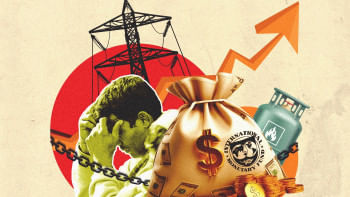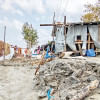How can we protect the poor from the inflationary pressure?

For the last couple of years, the rate of inflation projected by the Bangladesh Bureau of Statistics (BBS) has hovered within the range between 8.5 to 9.5 percent. This soaring inflation has further accentuated the agony of people following the shock of the Covid-19 pandemic, which had serious negative implications on the livelihoods of people, thereby affecting the consistent poverty reduction effort of the government.
To accommodate inflationary pressure, households are reducing expenditure on food and non-food items, changing their patterns of food consumption, acquiring second jobs, drawing from their savings, and borrowing from formal and informal sources, among other emergency measures. It is therefore not surprising that inflationary pressure may push some "vulnerable" households below the poverty line.
In this context, the recent Macro Poverty Outlook of the World Bank estimated that between fiscal year 2022-2023 and 2023-2024, price hikes may have pushed as many as five lakh Bangladeshis into extreme poverty, defined as sustenance on less than $2.15 a day (purchasing power adjusted), also known as the international poverty line. It was also projected that 8.4 lakh people will become moderately poor, living on less than $3.65 a day (purchasing power adjusted). According to the World Bank, both inflation and foreign exchange crises, on one hand, will contain private demand and on the other hand, will constrain private investment and job creation. Both are expected to put pressure on low-income people, leading to a higher rate of poverty.
A close analysis of the poverty statistics of the BBS shows a consistent reduction in poverty over the years with a fall in upper poverty rate from 24.3 percent in 2016 (lower poverty rate 12.9 percent) to 18.7 percent in 2022 (lower poverty rate 5.6 percent), despite the effect of the pandemic. Besides, the fall in the rural poverty rate was a bit steeper from 26.4 percent to 20.5 percent for the upper poverty line in comparison to a moderate decline in the urban poverty rate from 18.9 percent to 14.7 percent. A survey conducted by the South Asian Network on Economic Modelling in collaboration with the University of Manchester, however, found that between 2018 and 2023, though there has been a marginal reduction in upper poverty from 21.6 percent to 20.7 percent (lower poverty rate fell from 9.4 percent to 7.9 percent), there has been a rise in the upper poverty rate in urban areas, from 16.3 percent to 18.7 percent. The study also shows that, as part of their major coping strategy in the face of inflation, as many as 31 percent households changed their food habits, 24 percent drew savings, and 15 percent reduced non-food expenditure. The survey revealed that, in comparison to the earlier part of 2023 (April 2023), food insecurity has deteriorated in the later part of the year (October-November 2023), with urban households being in a worse position than their rural counterparts. The findings from this survey therefore strengthen the prediction about the deterioration of the country's poverty scenario.
While understanding the impact of inflationary pressure on household-level poverty, it is note-worthy that as people from low-income groups tend to spend a greater proportion of their income on food items, in the face of high food inflation, they could be the worst sufferers. As a consequence, their level of deprivation can worsen while some non-poor might fall below the poverty line. The current food inflation rate of 9.87 percent in March (non-food inflation rate being 9.64 percent) with the urban food inflation of 9.98 percent and rural 9.86 percent, therefore indicates that poor households in urban areas could be the worst victims of high inflation.
With the twin macro concerns of the government, that is, the depletion of foreign exchange reserve and the falling value of taka over US dollar, the central bank has taken different contractionary policy stances to tame the soaring inflation rate. As a result, the pace of job creation has slowed down, putting more pressure on those households with potential job applicants. The government in this case can incentivise the private sector through small tax rebates to safeguard the interests of the existing workers through programs including monthly rations and subsidised midday-meals.
The safety net program of the government needs to be expanded by several folds to comfort not only those at the bottom of the distribution but also the middle-income households. In this regard, the number of trucks for Open Market Sales needs to be increased by a significant margin and the sale price should be further subsidised. Besides, initiatives like rationing and fair-price shops need to be introduced and operated in both rural and urban areas.
The regular safety net allowances for those at the grassroots need to be expanded to urban areas too with a higher amount for per capita allocation. Besides, there is no denying that for countries like Bangladesh, efficient market management to have smooth operation along the supply chain can play a crucial role in maintaining a stable market-driven price level. Finally, in order to contain the inflationary pressure at the household level, particularly that generated by high import prices, it is extremely crucial to correct the macro scenario through effective fiscal and monetary policy tools.
Dr Sayema Haque Bidisha is a professor at the Department of Economics atthe University of Dhaka. She is also a research director at SANEM.
Views expressed in the article are the author's own.
Follow The Daily Star Opinion on Facebook for the latest opinions, commentaries and analyses by experts and professionals. To contribute your article or letter to The Daily Star Opinion, see our guidelines for submission.

 For all latest news, follow The Daily Star's Google News channel.
For all latest news, follow The Daily Star's Google News channel. 










Comments